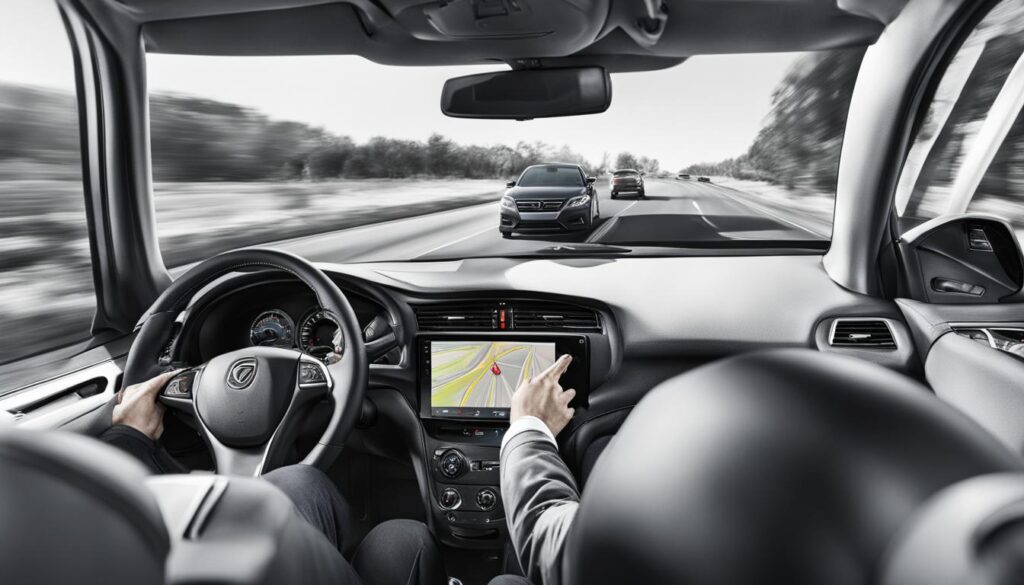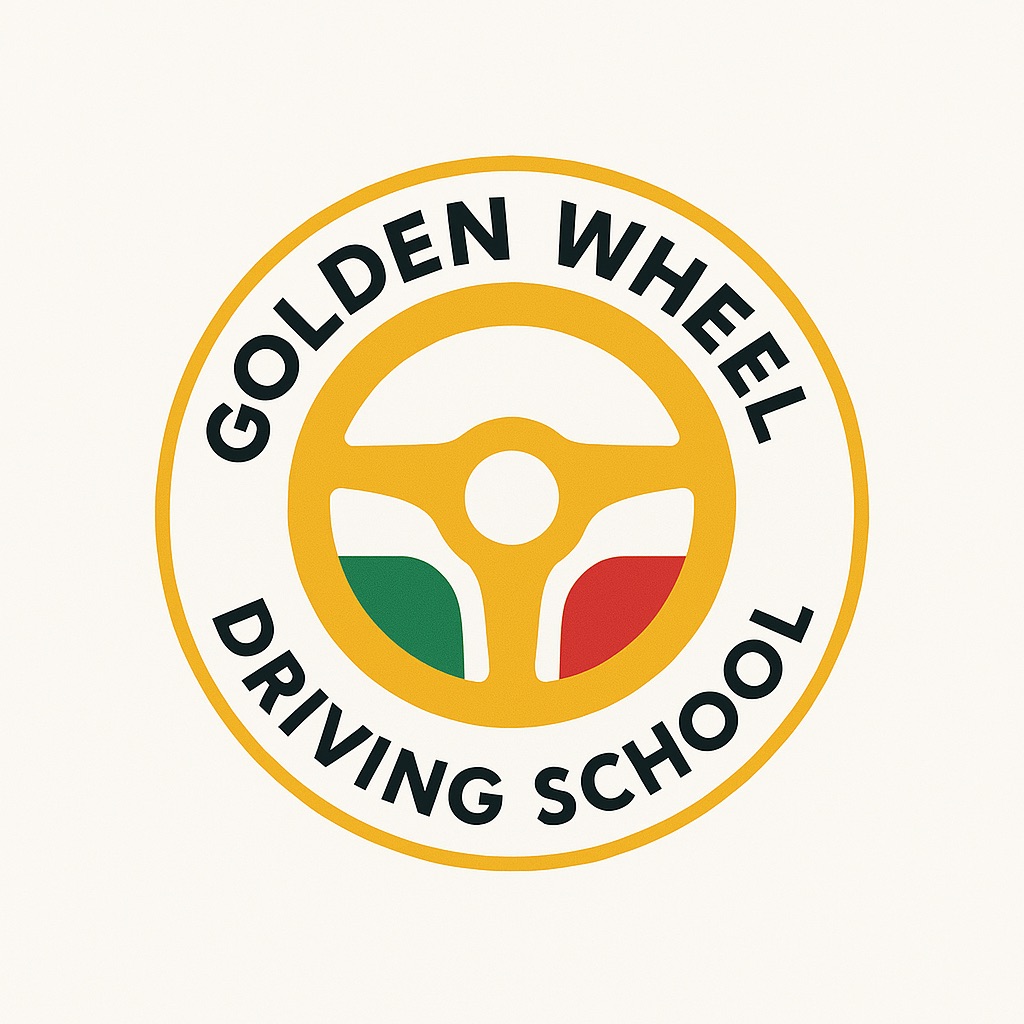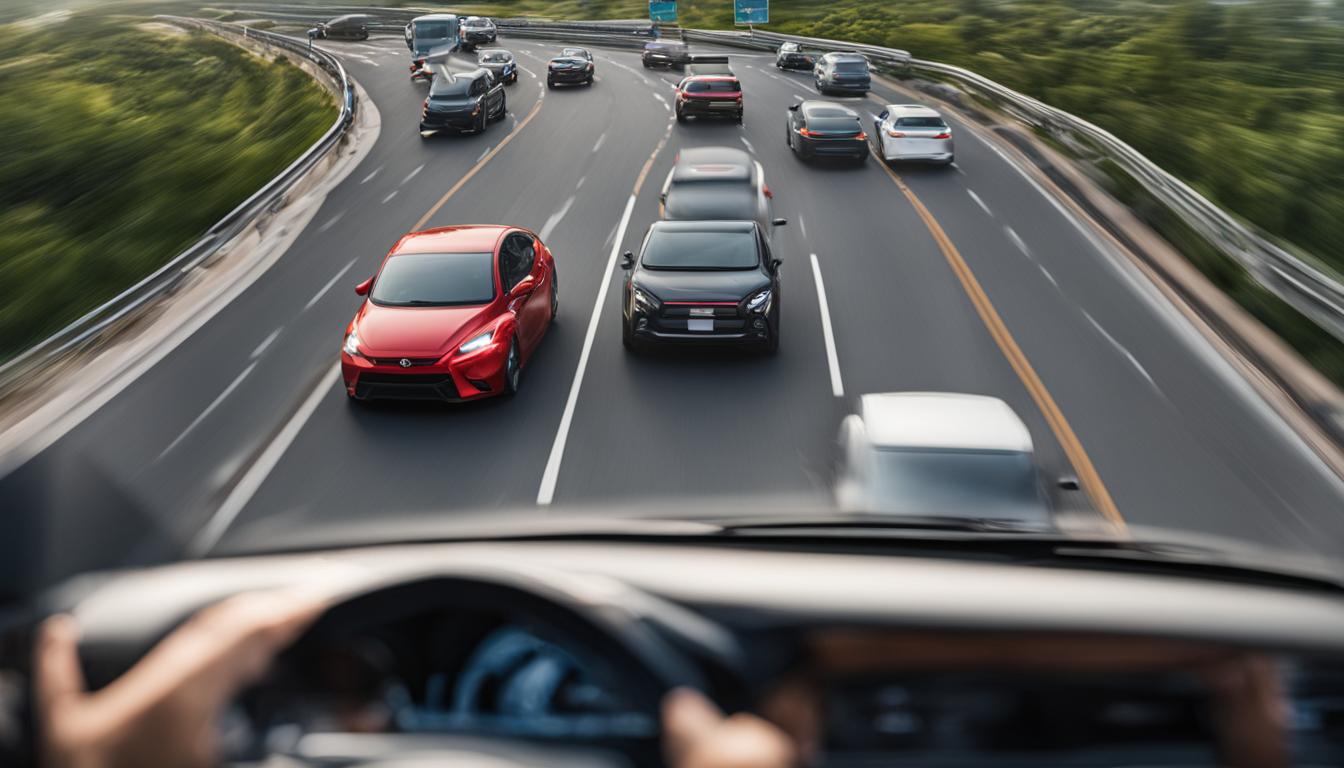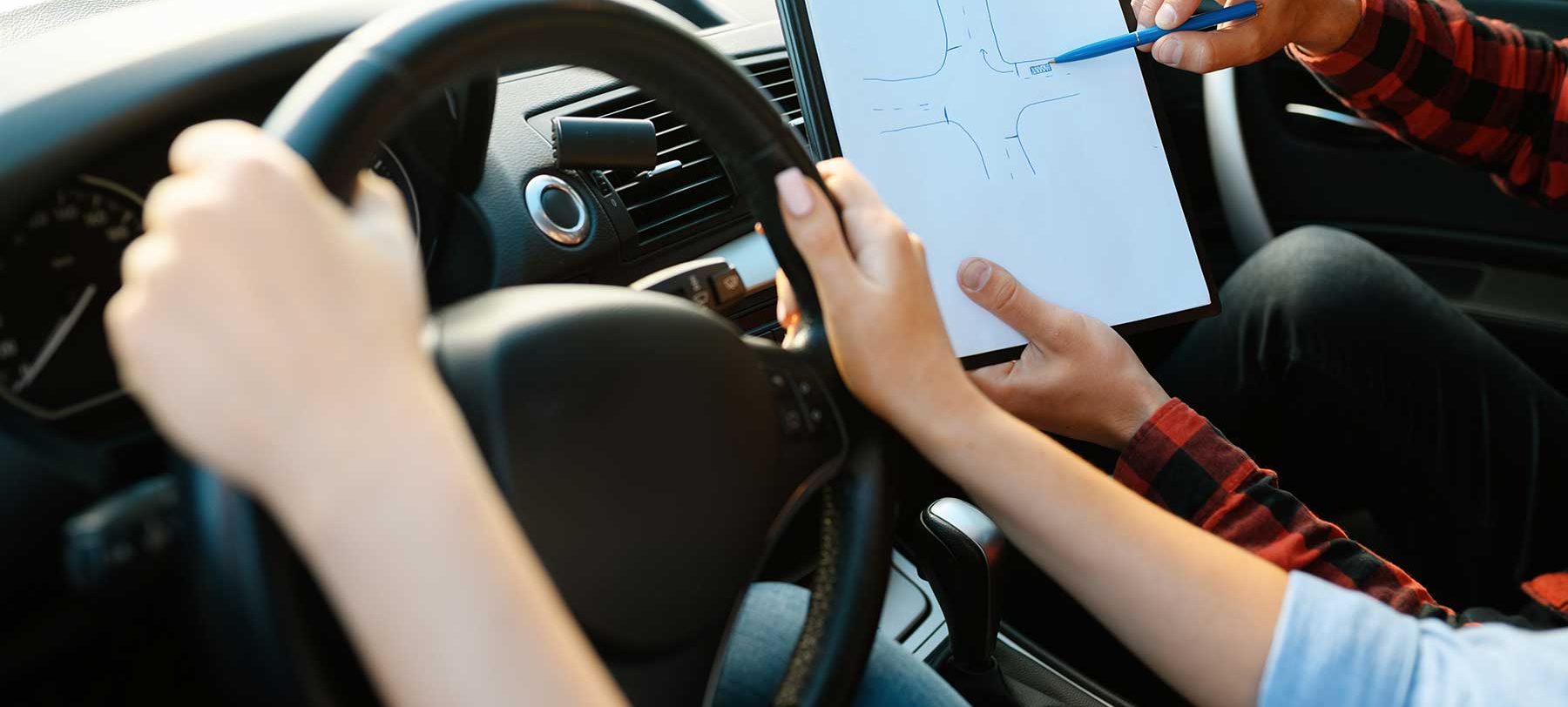Gaining the confidence to navigate the roads with expertise and safety requires mastering defensive driving techniques. Whether you’re a new driver or have years of experience behind the wheel, understanding how to maneuver your vehicle in different situations is crucial to becoming a safety-conscious motorist. At Golden Wheel Driving School, we prioritize teaching these techniques to empower drivers with the skills they need to stay safe on the road.
Key Takeaways:
- Mastering defensive driving techniques is essential for safe and confident driving.
- Golden Wheel Driving School is committed to teaching these techniques to drivers of all experience levels.
- Defensive driving techniques help prevent accidents and promote road safety.
- These techniques include maintaining focus, effective communication, and maintaining a safe distance.
- Regular vehicle maintenance and awareness of other drivers are also important defensive driving practices.
Mastering Focus and Alertness on the Road
To drive safely, it’s crucial to maintain focus and alertness on the road, especially in heavy traffic scenarios. Distractions can significantly impair your ability to react to potential hazards and can lead to accidents. Therefore, it is important to adopt strategies that help keep distractions at bay.
One effective strategy is to engage in audio content during long commutes. Listening to educational podcasts, audiobooks, or your favorite music can help you stay focused and engaged, allowing you to dedicate your full attention to the road.
Another important aspect of maintaining focus while driving is the ability to recognize potential hazards quickly. Developing a keen sense of situational awareness can help you identify and anticipate dangers, giving you ample time to react and avoid collisions.
“Maintaining focus and alertness on the road is paramount to ensure the safety of yourself and others. By staying vigilant and attentive, you can navigate through challenging traffic scenarios and prevent accidents.”
Here are some key tips to enhance concentration and ensure safer journeys:
- Avoid using electronic devices such as smartphones while driving. Keep them out of reach or use hands-free features if necessary.
- Minimize conversations with passengers that may divert your attention from the road.
- Limit eating or drinking while driving to prevent distractions.
- Take regular breaks during long drives to combat fatigue and maintain alertness.
By implementing these strategies and prioritizing your focus on the road, you can significantly reduce the risk of accidents and promote safer driving experiences.
Effective Communication While Driving
Communication is a vital aspect of driving, just like it is in team sports. When on the road, effective communication ensures smoother navigation and reduces the risk of accidents. One crucial tool for communication while driving is the consistent use of turn signals.
Turn signals serve as a universal language on the road, conveying your intentions to other drivers and enabling safe maneuvering. By using your turn signals properly, you can indicate your next move, whether it’s changing lanes, making a turn, or merging into traffic. This clear communication helps other drivers anticipate your actions and adjust their driving accordingly, reducing the chances of misunderstandings or collisions.
“Using turn signals consistently is like having a conversation with other drivers, letting them know your next move.”
Proper lane changing etiquette is critical for safe driving. When changing lanes, always check your blind spots and signal your intention in advance. This gives other drivers enough time to adjust their speed or distance, creating a safer driving environment for everyone.
At Golden Wheel Driving School, we emphasize the importance of effective communication while driving. Our experienced instructors teach students how to use turn signals correctly, fostering a culture of safe and considerate driving on the road.
Turn Signal Dos and Don’ts:
- Do use your turn signals well in advance of your intended action.
- Do signal consistently and give other drivers time to react.
- Do check your blind spots before changing lanes.
- Don’t neglect to use your turn signals, even if you think no one is around.
- Don’t rely solely on hand signals; always use your vehicle’s turn signals.
By prioritizing effective communication through the use of turn signals, you contribute to safer roads and a smoother driving experience for everyone.
| Benefits of Using Turn Signals | Consequences of Neglecting Turn Signals |
|---|---|
| 1. Enhances road safety | 1. Increased risk of collisions |
| 2. Promotes smoother traffic flow | 2. Misunderstandings and conflicts with other drivers |
| 3. Builds trust and predictability on the road | 3. Frustration and road rage from other drivers |
| 4. Reduces the risk of accidents and rear-end collisions | 4. Decreased visibility and awareness for other drivers |
Superior Driving Techniques for Enhanced Road Safety
To enhance road safety and prevent accidents, it is crucial to implement superior driving techniques that prioritize maintaining a safe distance from other vehicles and understanding the concept of buffer space, especially in traffic jams. By applying these techniques, you can significantly reduce the risk of collisions and create a safer driving environment for everyone on the road.
Estimating Safe Following Distances
One of the key aspects of superior driving techniques is estimating and maintaining a safe following distance from the vehicle in front of you. This ensures that you have enough time to react and brake in case of sudden changes or emergencies. To estimate a safe following distance, it is recommended to use the three-second rule: pick a fixed object on the road, such as a sign or a tree, and when the vehicle ahead passes that object, start counting. If you reach that object before completing the count, you are following too closely and should increase your distance.
Managing Patience and Positivity in Heavy Traffic
Traffic congestion can be frustrating, but as a defensive driver, it is essential to manage your patience and maintain a positive mindset while navigating through heavy traffic. Avoid aggressive behaviors such as tailgating or constantly changing lanes, as they only contribute to unsafe driving conditions. Instead, practice patience, remain calm, and stay in your lane, allowing the traffic to flow naturally without unnecessary disruptions.
“Patience is not the ability to wait, but the ability to keep a good attitude while waiting.”
Understanding Buffer Space
Buffer space refers to the area around your vehicle that provides you with an additional safety cushion. It allows you to react to any sudden changes or hazards that may arise on the road. By understanding and utilizing buffer space effectively, you can create a safe zone around your vehicle, minimizing the chances of collisions. This involves maintaining adequate lateral space from adjacent vehicles and leaving enough space in front of your car to account for both your vehicle’s stopping distance and the possibility of any sudden stops by the vehicle in front.
| Advantages of Maintaining Buffer Space | Benefits of Safe Distance |
|---|---|
| – Provides a safety cushion during sudden stops | – Allows for better visibility and reaction time |
| – Reduces the risk of rear-end collisions | – Prevents chain-reaction accidents |
| – Creates a protective zone around your vehicle | – Enhances overall road safety |
By implementing these superior driving techniques, including estimating safe following distances, managing patience and positivity, and understanding buffer space, you can greatly enhance road safety and contribute to a smoother and more secure driving experience. Remember, driving defensively is not just about protecting yourself but also safeguarding the well-being of others sharing the road with you.
Ensuring Optimal Vehicle Condition
Regular tire maintenance is essential for safe driving. Worn tires can significantly affect vehicle performance and compromise road safety. By taking proactive measures to maintain your vehicle, you can minimize the risk of accidents and ensure a smooth and secure driving experience.
Why Regular Tire Maintenance Matters
Tires play a vital role in the overall performance and safety of your vehicle. Over time, tires can wear out due to normal usage, road conditions, and weather elements. Regular tire maintenance not only extends the lifespan of your tires but also enhances their performance and ensures optimal traction on the road. By keeping your tires in the best possible condition, you can maintain control and stability.
The Importance of Tire Inspections
Regular tire inspections are crucial for identifying potential issues and addressing them promptly. Inspect your tires for signs of wear, such as uneven tread wear, bulges, or cracks. Additionally, check the tire pressure regularly to ensure it meets the manufacturer’s recommendations. Proper tire inflation helps optimize fuel efficiency and promotes better handling.
Proper Tire Rotation
Rotating your tires at regular intervals is essential for maintaining even tread wear. This helps prolong the life of your tires and improves overall vehicle performance. Consult your vehicle’s owner manual or seek professional advice to determine the recommended tire rotation pattern for your specific vehicle.
Choosing the Right Tires
When it’s time to replace your tires, it’s essential to choose the right ones for your vehicle. Consider factors such as your driving style, climate conditions, and manufacturer recommendations when selecting new tires. Investing in high-quality tires that are suitable for your vehicle’s specifications will help maximize safety and performance.
Tire Balancing and Alignment
Tire balancing and alignment are crucial for maintaining stability and preventing premature tire wear. Balancing ensures that the weight distribution among all four tires is even, while alignment ensures that the tires are correctly aligned with the vehicle’s suspension. Regular tire balancing and alignment can prevent issues such as vibrations, steering instability, and uneven tire wear.
Complete Tire Care Table
| Tire Maintenance Task | Benefits |
|---|---|
| Regular tire inspections | Early identification and resolution of potential tire issues |
| Tire rotation | Prolonged tire lifespan and improved vehicle performance |
| Choosing the right tires | Enhanced safety and optimal performance |
| Tire balancing and alignment | Improved stability, reduced tire wear, and enhanced handling |
Regular tire maintenance is an essential aspect of safe driving. By prioritizing tire care and following recommended maintenance practices, you can ensure that your vehicle remains in optimal condition, reducing the risk of accidents and promoting road safety. Remember, taking care of your tires is taking care of your safety.
Pay Attention
Defensive driving requires full awareness of your surroundings. It is crucial to pay attention to what’s happening in front, behind, and beside your car. By maintaining a high level of awareness, you can anticipate potential hazards and take appropriate actions to prevent accidents.
Avoiding distractions is a key aspect of maintaining focus while driving. Electronic devices are one of the biggest distractions on the road. Resisting the temptation to use them while driving is essential for your safety and the safety of others.
I always keep my phone out of reach and sight while driving. It helps me stay focused on the road and avoid any unnecessary distractions.
Another important aspect of paying attention is being mindful of your own driving behavior. Speeding and reckless maneuvers can undermine your ability to respond to unexpected situations. By adopting a mindset of attentiveness and responsibility, you can contribute to a safer driving environment for everyone.
| Common Driving Distractions | Impact on Awareness |
|---|---|
| Texting or using a smartphone | Significantly reduces awareness |
| Eating or drinking | Distracts attention from the road |
| Talking to passengers | Can divert focus from driving |
| Adjusting music or navigation | Temporarily distracts attention |
Eliminating distractions and staying fully engaged with your surroundings are vital for safe driving. By prioritizing awareness and avoiding distractions, you can reduce the risk of accidents and ensure a safer journey.
Observe Other Drivers
While I focus on my own driving, I understand the importance of being aware of what other drivers are doing on the road. By observing their behavior, I can anticipate potential hazards and take proactive measures to avoid collisions. Maintaining awareness not only keeps me safe but also contributes to overall road safety.
“Anticipate other drivers’ actions to stay one step ahead and ensure a smooth and secure journey.”
One effective way to anticipate other drivers’ actions is to pay attention to their body language and the movements of their vehicles. A slight swerve or sudden lane change can indicate potential hazards. By staying alert and aware, I can react quickly and prevent accidents.
Golden Wheel Driving School Tips:
- Keep a safe distance: Maintain a safe following distance from the vehicle in front of you to allow for sudden stops or unexpected maneuvers.
- Watch for turn signals: Be attentive to other drivers’ turn signals, as they can provide valuable insights into their intended actions.
- Stay out of blind spots: Avoid lingering in another driver’s blind spot, as they may not be aware of your presence.
- Adapt to traffic flow: Observe the speed and behavior of surrounding vehicles to anticipate changes in traffic patterns.
| Situation | Action to Take |
|---|---|
| The car ahead is braking suddenly | Brake immediately, while maintaining a safe distance to avoid a rear-end collision. |
| A driver is merging into my lane | Adjust your speed or switch lanes to create a safe space for the merging vehicle. |
| Another driver is exhibiting erratic behavior | Gently reduce speed and maintain a safe distance, allowing the unpredictable driver to move ahead or change lanes. |

Being proactive in observing other drivers helps me anticipate potential dangers on the road. By maintaining awareness, I can react swiftly and ensure a safer driving experience for myself and those around me.
Next, let’s explore the vital skills required to respond effectively to various emergencies on the road.
Know How to Respond to Various Emergencies
In order to master defensive driving, it is important to know how to respond to various emergencies on the road. Being prepared for unexpected situations can potentially save lives. Here are a few key tips to keep in mind:
Skidding on Black Ice
Skidding on black ice is a common hazard during winter months, and it can be extremely dangerous. When encountering black ice:
- Maintain a calm demeanor and avoid panic.
- Gently remove your foot from the gas pedal to avoid accelerating further.
- Avoid sudden braking, as it can cause the vehicle to skid even more.
- Steer into the skid by turning your wheel in the direction that the rear of the vehicle is sliding.
- Gradually regain control by slowly and smoothly steering back in the desired direction.
Remember, practice and experience are key when it comes to handling skids. Consider taking a defensive driving course to learn how to confidently navigate this and other emergency situations.
Swerving to Avoid Other Cars or Animals
Encountering sudden obstacles on the road, such as other cars or animals, requires quick thinking and decisive action. Here’s what to do:
- Assess the situation and determine whether it’s safer to swerve or stop.
- If swerving is the best option, signal your intentions and check your blind spots.
- Steer smoothly and gradually in the direction necessary to avoid the obstacle while maintaining control of your vehicle.
- Stay aware of other vehicles around you and adjust your course accordingly to avoid collisions.
- Once you’ve successfully avoided the obstacle, continue driving with caution and be prepared for any further emergencies.
Keep in mind that swerving should only be done when it’s safe to do so and when there are no other potential hazards in the way. Prioritize your own safety and the safety of others on the road.
By understanding how to respond effectively in different emergency situations, you can enhance your defensive driving skills and mitigate potential risks on the road.
Quote:
“Being prepared for emergencies on the road is not just about your safety, but the safety of everyone around you. It’s essential to know how to react in different situations to avoid accidents and potentially save lives.” – John Smith, Defensive Driving Expert
Drive at a Safe Speed
When it comes to road safety, speed plays a critical role. Driving at a safe speed can significantly reduce the risk of accidents and ensure the well-being of all road users. It is essential to adhere to the posted speed limits set by authorities and adjust your speed according to the prevailing conditions.
By driving at a safe speed, you allow yourself ample time to react to unexpected situations on the road. Whether it’s a sudden stop by the vehicle ahead or a pedestrian crossing the street, being within the safe driving speed range enhances your ability to make informed decisions and take appropriate actions.
Speed limits are set based on various factors, including traffic volume, road conditions, and pedestrian activity. Respecting these limits demonstrates your commitment to road safety and your duty as a responsible driver.
While it may be tempting to exceed the speed limit, especially when rushing to reach a destination, it is crucial to remind ourselves of the potential consequences. Speeding not only decreases your control over the vehicle but also reduces the effectiveness of protective measures such as seatbelts and airbags in the event of a collision.
In addition to following speed limits, it’s essential to adjust your speed based on external factors like weather, visibility, and road conditions. For example, when driving in heavy rain or ice, reducing your speed allows for better traction and minimizes the risk of skidding or losing control of the vehicle.
Benefits of Driving at a Safe Speed:
- Reduced risk of accidents
- Improved reaction time
- Enhanced vehicle control
- Increased effectiveness of protective measures
- Greater attentiveness to the road environment
Remember, driving at a safe speed is not only a legal requirement but also a moral responsibility to protect yourself, your passengers, and other road users. Prioritize road safety and always drive within the appropriate speed limits for a smoother, safer journey.

| Situation | Speed Limit | Safe Driving Speed |
|---|---|---|
| Residential Areas | 25 mph | 25 mph or below, considering children and pedestrians |
| City Streets | 35 mph | 35 mph or below, adjusting for traffic and intersections |
| Highways | Varies (e.g., 55 mph, 65 mph) | Posted speed limit or below, considering traffic flow and weather conditions |
Eliminate Distractions
Distracted driving is a serious threat on the road, putting not only your life at risk but also the lives of others. To ensure your safety and the safety of those around you, it is crucial to eliminate distractions while driving. By avoiding activities that divert your attention, you can focus on the road and practice defensive driving techniques.
One of the most common distractions is the use of electronic devices. Whether it’s texting, talking on the phone, or navigating through apps, these activities take your eyes and attention away from the road. To avoid this, it is recommended to put your phone on silent or use hands-free devices for calls. Remember, the message or notification can wait. Your safety is more important.
Another major distraction is eating or drinking while driving. Although it may seem harmless, eating or drinking can take your hands off the wheel and divert your attention away from the road. It is best to enjoy your meals before or after your journey, or simply pull over to a safe location if you need to eat or drink.
Engaging in other activities that require your attention, such as grooming or adjusting the radio or GPS, can also lead to distracted driving. These actions should be done before you start driving or when you have pulled over to the side of the road.
Remember, when you are behind the wheel, your focus should solely be on driving. It only takes a moment of distraction to cause a life-altering accident. Stay alert, stay focused, and eliminate distractions.
“The only thing I plan on multitasking while driving is breathing and keeping my eyes on the road.” – Anonymous
The Impact of Distracted Driving
To understand the gravity of distracted driving, let’s take a look at some statistics:
| Year | Number of Fatalities | Percentage of Distracted Driving-Related Fatalities |
|---|---|---|
| 2017 | 3,166 | 8.5% |
| 2018 | 3,166 | 8.5% |
| 2019 | 3,142 | 8.7% |
As you can see, distracted driving has consistently contributed to a significant number of fatalities on the road. These alarming numbers serve as a reminder of the importance of eliminating distractions and practicing safe driving habits.
By taking the necessary steps to avoid distractions, we can all contribute to safer roads and protect ourselves and others from unnecessary accidents and injuries. Let’s prioritize safety and make a conscious effort to eliminate distractions while driving.
Control Your Emotions
When it comes to defensive driving, one crucial aspect that cannot be overlooked is controlling your emotions behind the wheel. Road rage and aggressive driving behaviors not only put your own safety at risk but also jeopardize the well-being of others on the road.
Aggressive driving can take many forms, such as tailgating, sudden lane changes, and excessive speeding. These behaviors can escalate tensions on the road, leading to accidents and potentially life-threatening situations.
By staying calm and patient while driving, you contribute to the creation of safer roads for everyone. Remember that you have the power to control your emotions and avoid engaging in aggressive driving behaviors. Take a deep breath, keep a level head, and remember that arriving safely at your destination is more important than any minor inconvenience along the way.
“Stay calm and patient while driving. Remember that you have the power to control your emotions and avoid engaging in aggressive driving behaviors.”
Golden Wheel Driving School – Promoting Safe Driving Practices
At Golden Wheel Driving School, we believe in promoting safe driving practices and providing comprehensive training to ensure the well-being of our students and the community. Our experienced instructors emphasize the importance of defensive driving techniques and encourage students to maintain composure in challenging driving situations.
By learning to control your emotions on the road, you become not only a safer driver but also a positive influence in reducing road rage incidents and aggressive driving behaviors. Together, we can create an environment where all motorists prioritize road safety and respect for one another.
Take the first step towards becoming a responsible and skilled driver by enrolling in our defensive driving courses. Contact Golden Wheel Driving School today at 201-797-5858 or visit our website at www.goldenwheeldrivingschool.com to learn more about our programs and schedules.
| Consequences of Aggressive Driving | Ways to Control Emotions |
|---|---|
| 1. Increased risk of accidents and injuries | 1. Take deep breaths and practice relaxation techniques |
| 2. Escalation of tensions on the road | 2. Listen to calming music or podcasts |
| 3. Legal consequences, such as fines and license suspension | 3. Create a positive driving environment by being courteous |
| 4. Negative impact on mental and emotional well-being | 4. Practice patience and focus on the bigger picture |
Conclusion
Mastering defensive driving techniques is crucial for ensuring road safety. By honing our focus, communication skills, distance management, and vehicle upkeep, we can create a safer driving environment for ourselves and others. At Golden Wheel Driving School, located at 75 Broadway, Elmwood Park, NJ 07407, we prioritize teaching these essential defensive driving tips to our students.
Safe driving practices involve maintaining focus and alertness on the road, using turn signals effectively, and practicing patience in heavy traffic. Regular tire maintenance and awareness of optimal vehicle condition are also key. Eliminating distractions, controlling emotions, and driving at a safe speed contribute to a better driving experience.
Road safety is a shared responsibility, and each of us plays a vital role in ensuring it. By implementing these defensive driving tips, we can reduce accidents, protect lives, and create a safer commuting environment for everyone. For more information on defensive driving techniques, call Golden Wheel Driving School at Tel. 201-797-5858.
FAQ
Why is it important to master defensive driving techniques?
Mastering defensive driving techniques is crucial for becoming a safety-conscious motorist and ensuring road safety.
How can I maintain focus and alertness on the road?
Strategies such as avoiding distractions, engaging in audio content, and quickly recognizing potential hazards can enhance concentration while driving.
Why is communication important while driving?
Communication through consistent use of turn signals helps ensure safe navigation through traffic congestion and effective lane changing.
How can I maintain a safe distance from other vehicles?
Maintaining a safe distance and understanding the concept of buffer space in traffic jams contribute to safer highways and prevent accidents.
Why is regular tire maintenance important?
Regular tire maintenance is crucial for safe driving as worn tires can affect vehicle performance and safety.
How can I avoid distractions while driving?
By avoiding the use of electronic devices and engaging in other distracting activities, you can maintain focus and prevent accidents.
Why is it important to observe other drivers?
Observing other drivers’ behavior helps anticipate potential hazards and avoid collisions on the road.
What should I do in various emergencies on the road?
Knowing how to handle skidding on black ice, swerving to avoid other cars or animals, and reacting effectively in different situations is essential for defensive driving.
How can I drive at a safe speed?
Adhering to speed limits and maintaining a speed appropriate for the conditions help prevent accidents and ensure road safety.
How can I eliminate distractions while driving?
Avoiding the use of electronic devices, eating, and engaging in any activities that take your attention away from the road can help practice defensive driving and prevent accidents.
How can I control my emotions while driving?
Staying calm and patient, and avoiding aggressive driving behaviors such as tailgating, sudden lane changes, and speeding, contribute to safer roads for everyone.
What are some defensive driving techniques?
Defensive driving techniques include maintaining focus, communication, managing distance, and ensuring vehicle upkeep to enhance road safety.







